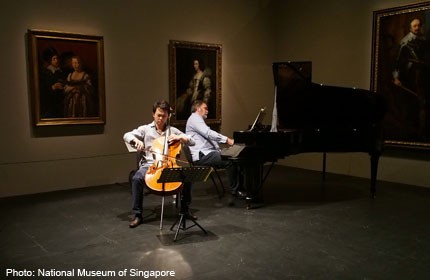History of cello through music

Review: Concert The Magnificent Cello
Qin Li-Wei, cello, Bernard Lanskey, piano
National Museum of Singapore/Tuesday
For the penultimate concert in the Music At An Exhibition series at the National Museum, the cello took centre stage.
It was a delightful hour of music that traced the instrument's development in the 18th century. About 80 years spanned the works performed by Chinese-Australian cellist Qin Li-Wei on his trusty 1780 Joseph Guadagnini cello.
Some purists prefer J.S. Bach's Cello Suites to be heard on a baroque cello or the viola da gamba, but this music transcends eras and time.
The opening Prelude of Suite No. 1 In G Major is possibly the most familiar of Bach's music for the instrument, but here it sounded as though freshly minted.
The full-throated baritone coaxed by Qin was both soothing and arresting and, like a master storyteller spinning a yarn, the cellist made you want to care.
The following movements were varied period dances, taken at a faster clip in the Courante and Minuets.
The Sarabande, with its widely spread chords and deeply breathed air, gently held one captive. It was the bounding rhythm of the Gigue that allowed some relaxation in attention.
Qin was joined by Australian pianist Bernard Lanskey, also director of the Yong Siew Toh Conservatory of Music, in Luigi Boccherini's Cello Sonata No. 6 In A Major.
By now, baroque convention had given way to the sleeker and less contrapuntal lines of the classical tradition. The prayer-like slow opening movement offered the display of an exquisite singing tone, while the ensuing Allegro was martial in character but one which smiled from ear to ear.
Beethoven was made of sterner stuff, and in his Cello Sonata No. 2 In G Minor (Op.5 No. 2), the piano graduated to become an equal partner with the cello.
Lanskey spoke about the metamorphosis of the genre, with reference to the paintings on the Metamorphoses Of Ovid from the Liechtenstein Royal Collection. The epic canvases he alluded to also applied to the sonata.
Its first movement was in effect a slow and serious introduction, opening with a grim G minor chord and one filled with pathos.
The early Romantic movement, which Beethoven was part of, meant that passion was often worn heart-on-sleeve.
True feelings lurked below its calm exterior, and this erupted in the fast second movement, when pent-up emotion found a joyous release. The contrasts and transition provided by the duo were startling in their immediacy.
The finale's Rondo was even more cheerful, with the piano taking the fore. Its passages of running notes could have been more cleanly dealt with, but the comedic timing with the cello was always first priority.
With the ice thawed and melted, Beethoven could always be relied upon to turn up the heat, and this spiritedly closed the concert proper.
The encore, an effective transcription of Bach's sublime Air in G major, was also much loved by the appreciative audience.
From now till 29 September 2013, visitors may enjoy a special 1-for-1 admission to the exhibition by simply flashing the attached visual (also available on National Museum's website and Facebook here: https://on.fb.me/18knL8G).
Details of the exhibition are as follows -
Princely Treasures from the House of Liechtenstein On now till Sunday, 29 September 2013 10am to 6pm daily Exhibition Gallery 1 and 2, Basement, National Museum of Singapore
$10 for 2 pax (includes SISTIC handling fees)

Get a copy of The Straits Times or go to straitstimes.com for more stories.